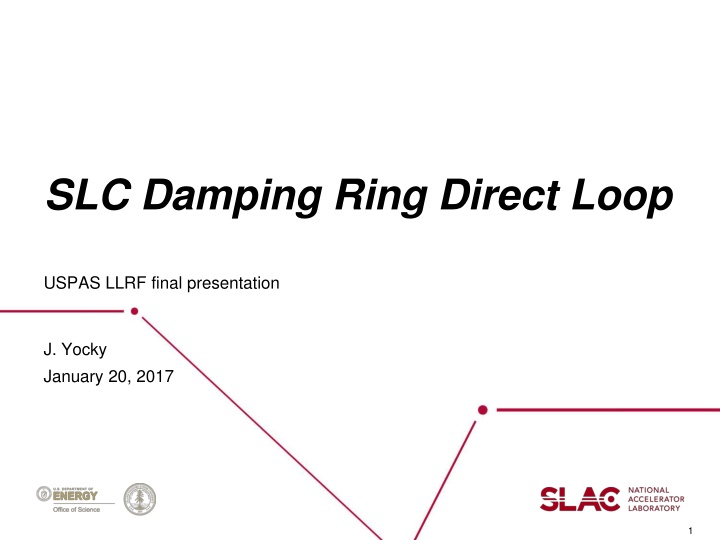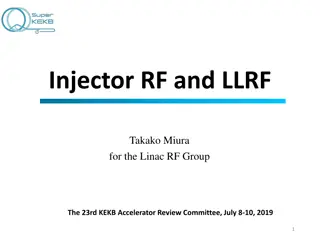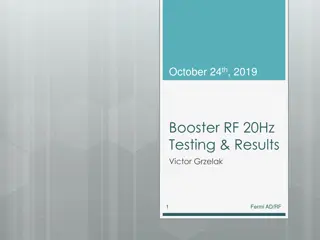
Challenges of SLC Damping Ring Direct Loop System
Explore the system overview and problem faced by the SLC Damping Ring Direct Loop, addressing issues with beam loading instability and cavity voltage tuning. Delve into the modeled behavior, phasor representations of currents, and gain and stability limits within the system, offering insights into impedance functions and feedback transfer functions.
Download Presentation

Please find below an Image/Link to download the presentation.
The content on the website is provided AS IS for your information and personal use only. It may not be sold, licensed, or shared on other websites without obtaining consent from the author. If you encounter any issues during the download, it is possible that the publisher has removed the file from their server.
You are allowed to download the files provided on this website for personal or commercial use, subject to the condition that they are used lawfully. All files are the property of their respective owners.
The content on the website is provided AS IS for your information and personal use only. It may not be sold, licensed, or shared on other websites without obtaining consent from the author.
E N D
Presentation Transcript
SLC Damping Ring Direct Loop USPAS LLRF final presentation J. Yocky January 20, 2017 1
System Overview and the Problem SLC Damping Ring 1.19GeV Up to 5e10 e-/bunch Two bunch operation One 60kW klystron driving two RF accelerating cavities of two cells each for a total of 1MV Instability threshold In order to prevent turbulent bunch lengthening, voltage is ramped down mid- store to keep bunch length long until extraction when voltage is ramped back to nominal The Problem At low cavity voltage, beam loading instability occurs because cavities tuned for optimum loading angle of 0 when at max voltage Cavity tuning angle fixed during store due to mechanical tuners not fast enough to compensate
Inside the ring Klystron in ring to right Temperature stabilized to 105F
System Representation Model the system as a resonant cavity driven by two current sources: the klystron and the beam. I_T=current in cavity I_B=beam current I_G=generator current (klystron) V_c=voltage of cavity G=RF feedback V_ref=Klystron Drive Signal V_ref
Phasor Representation of Currents I_O=Real part of total current in cavity _B=Beam phase determined by synchronous phase of particle _Z=Impedance angle determined by cavity tuning wrt klystron _L=Loading angle determined by angle between klystron current and cavity voltage IG=??(1 + ??? ?) cos ? ??? ?=??? ? ???? ? 1 + ???? _?
Modeled Behavior Impedance function for ring parameters Feedback transfer function where ??= gain, ???= cavity shunt impedance, and T=delay Impedance for cavity plus feedback
Gain and stability limits Stability criteria: Shaded region in plot at positive phase is anti- damping of synchrotron oscillations. Curved region on left is exponential growth. Vertical axis is Y=I_B/I_O. At cavity frequency, Z=R_SH and G=G_0/R_SH, so effective impedance is reduced as 1/(1+G_0). Real part of cavity current increase by (1+G_0) and raises the shaded region on left by this amount. Nyquist plot on right shows stability limit with (dashed line) and without feedback. Phase shifts cause rotation and gain increase push curve to left. Allowing for phase margin limits effective impedance reduction
Direct Loop RF Feedback Implementation Klystron and cavities are in tunnel, so signal path lengths are short Two-cell cavities have a non-accelerating 0-mode which is close to the accelerating pi-mode Probe signals from the cells combined with phase shifters and attenuators to suppress 0-mode Cavity signals are then combined with phase shift and attenuation Common phase and attenuation to tune feedback parameters remotely
Observations Direct Loop behaves as predicted from model Suppresses beam loading instability Straight forward implementation Relatively simple design Robust Allows for physics parameters to be pushed





















